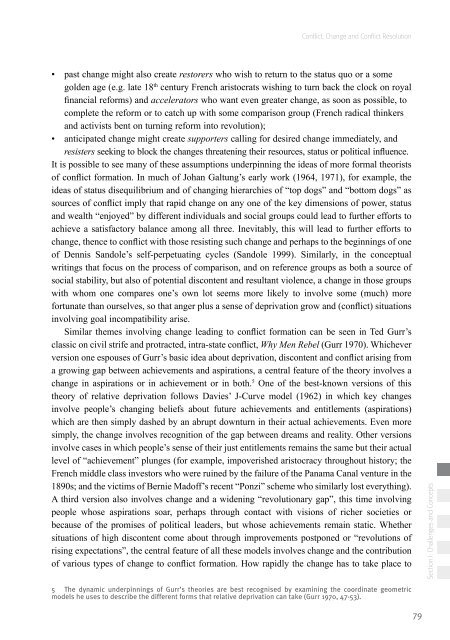Conflict, Change and Conflict Resolution - Berghof Handbook for ...
Conflict, Change and Conflict Resolution - Berghof Handbook for ...
Conflict, Change and Conflict Resolution - Berghof Handbook for ...
You also want an ePaper? Increase the reach of your titles
YUMPU automatically turns print PDFs into web optimized ePapers that Google loves.
<strong>Conflict</strong>, <strong>Change</strong> <strong>and</strong> <strong>Conflict</strong> <strong>Resolution</strong><br />
• past change might also create restorers who wish to return to the status quo or a some<br />
golden age (e.g. late 18 th century French aristocrats wishing to turn back the clock on royal<br />
financial re<strong>for</strong>ms) <strong>and</strong> accelerators who want even greater change, as soon as possible, to<br />
complete the re<strong>for</strong>m or to catch up with some comparison group (French radical thinkers<br />
<strong>and</strong> activists bent on turning re<strong>for</strong>m into revolution);<br />
• anticipated change might create supporters calling <strong>for</strong> desired change immediately, <strong>and</strong><br />
resisters seeking to block the changes threatening their resources, status or political influence.<br />
It is possible to see many of these assumptions underpinning the ideas of more <strong>for</strong>mal theorists<br />
of conflict <strong>for</strong>mation. In much of Johan Galtung’s early work (1964, 1971), <strong>for</strong> example, the<br />
ideas of status disequilibrium <strong>and</strong> of changing hierarchies of “top dogs” <strong>and</strong> “bottom dogs” as<br />
sources of conflict imply that rapid change on any one of the key dimensions of power, status<br />
<strong>and</strong> wealth “enjoyed” by different individuals <strong>and</strong> social groups could lead to further ef<strong>for</strong>ts to<br />
achieve a satisfactory balance among all three. Inevitably, this will lead to further ef<strong>for</strong>ts to<br />
change, thence to conflict with those resisting such change <strong>and</strong> perhaps to the beginnings of one<br />
of Dennis S<strong>and</strong>ole’s self-perpetuating cycles (S<strong>and</strong>ole 1999). Similarly, in the conceptual<br />
writings that focus on the process of comparison, <strong>and</strong> on reference groups as both a source of<br />
social stability, but also of potential discontent <strong>and</strong> resultant violence, a change in those groups<br />
with whom one compares one’s own lot seems more likely to involve some (much) more<br />
<strong>for</strong>tunate than ourselves, so that anger plus a sense of deprivation grow <strong>and</strong> (conflict) situations<br />
involving goal incompatibility arise.<br />
Similar themes involving change leading to conflict <strong>for</strong>mation can be seen in Ted Gurr’s<br />
classic on civil strife <strong>and</strong> protracted, intra-state conflict, Why Men Rebel (Gurr 1970). Whichever<br />
version one espouses of Gurr’s basic idea about deprivation, discontent <strong>and</strong> conflict arising from<br />
a growing gap between achievements <strong>and</strong> aspirations, a central feature of the theory involves a<br />
change in aspirations or in achievement or in both. 5 One of the best-known versions of this<br />
theory of relative deprivation follows Davies’ J-Curve model (1962) in which key changes<br />
involve people’s changing beliefs about future achievements <strong>and</strong> entitlements (aspirations)<br />
which are then simply dashed by an abrupt downturn in their actual achievements. Even more<br />
simply, the change involves recognition of the gap between dreams <strong>and</strong> reality. Other versions<br />
involve cases in which people’s sense of their just entitlements remains the same but their actual<br />
level of “achievement” plunges (<strong>for</strong> example, impoverished aristocracy throughout history; the<br />
French middle class investors who were ruined by the failure of the Panama Canal venture in the<br />
1890s; <strong>and</strong> the victims of Bernie Madoff’s recent “Ponzi” scheme who similarly lost everything).<br />
A third version also involves change <strong>and</strong> a widening “revolutionary gap”, this time involving<br />
people whose aspirations soar, perhaps through contact with visions of richer societies or<br />
because of the promises of political leaders, but whose achievements remain static. Whether<br />
situations of high discontent come about through improvements postponed or “revolutions of<br />
rising expectations”, the central feature of all these models involves change <strong>and</strong> the contribution<br />
of various types of change to conflict <strong>for</strong>mation. How rapidly the change has to take place to<br />
5 The dynamic underpinnings of Gurr’s theories are best recognised by examining the coordinate geometric<br />
models he uses to describe the different <strong>for</strong>ms that relative deprivation can take (Gurr 1970, 47-53).<br />
79<br />
Section I: Challenges <strong>and</strong> Concepts
















